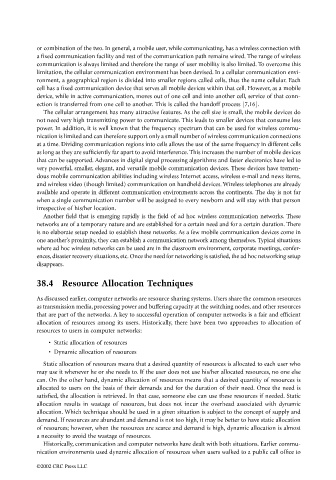Page 1078 - The Mechatronics Handbook
P. 1078
or combination of the two. In general, a mobile user, while communicating, has a wireless connection with
a fixed communication facility and rest of the communication path remains wired. The range of wireless
communication is always limited and therefore the range of user mobility is also limited. To overcome this
limitation, the cellular communication environment has been devised. In a cellular communication envi-
ronment, a geographical region is divided into smaller regions called cells, thus the name cellular. Each
cell has a fixed communication device that serves all mobile devices within that cell. However, as a mobile
device, while in active communication, moves out of one cell and into another cell, service of that conn-
ection is transferred from one cell to another. This is called the handoff process [7,16].
The cellular arrangement has many attractive features. As the cell size is small, the mobile devices do
not need very high transmitting power to communicate. This leads to smaller devices that consume less
power. In addition, it is well known that the frequency spectrum that can be used for wireless commu-
nication is limited and can therefore support only a small number of wireless communication connections
at a time. Dividing communication regions into cells allows the use of the same frequency in different cells
as long as they are sufficiently far apart to avoid interference. This increases the number of mobile devices
that can be supported. Advances in digital signal processing algorithms and faster electronics have led to
very powerful, smaller, elegant, and versatile mobile communication devices. These devices have tremen-
dous mobile communication abilities including wireless Internet access, wireless e-mail and news items,
and wireless video (though limited) communication on handheld devices. Wireless telephones are already
available and operate in different communication environments across the continents. The day is not far
when a single communication number will be assigned to every newborn and will stay with that person
irrespective of his/her location.
Another field that is emerging rapidly is the field of ad hoc wireless communication networks. These
networks are of a temporary nature and are established for a certain need and for a certain duration. There
is no elaborate setup needed to establish these networks. As a few mobile communication devices come in
one another’s proximity, they can establish a communication network among themselves. Typical situations
where ad hoc wireless networks can be used are in the classroom environment, corporate meetings, confer-
ences, disaster recovery situations, etc. Once the need for networking is satisfied, the ad hoc networking setup
disappears.
38.4 Resource Allocation Techniques
As discussed earlier, computer networks are resource sharing systems. Users share the common resources
as transmission media, processing power and buffering capacity at the switching nodes, and other resources
that are part of the networks. A key to successful operation of computer networks is a fair and efficient
allocation of resources among its users. Historically, there have been two approaches to allocation of
resources to users in computer networks:
• Static allocation of resources
• Dynamic allocation of resources
Static allocation of resources means that a desired quantity of resources is allocated to each user who
may use it whenever he or she needs to. If the user does not use his/her allocated resources, no one else
can. On the other hand, dynamic allocation of resources means that a desired quantity of resources is
allocated to users on the basis of their demands and for the duration of their need. Once the need is
satisfied, the allocation is retrieved. In that case, someone else can use these resources if needed. Static
allocation results in wastage of resources, but does not incur the overhead associated with dynamic
allocation. Which technique should be used in a given situation is subject to the concept of supply and
demand. If resources are abundant and demand is not too high, it may be better to have static allocation
of resources; however, when the resources are scarce and demand is high, dynamic allocation is almost
a necessity to avoid the wastage of resources.
Historically, communication and computer networks have dealt with both situations. Earlier commu-
nication environments used dynamic allocation of resources when users walked to a public call office to
©2002 CRC Press LLC

